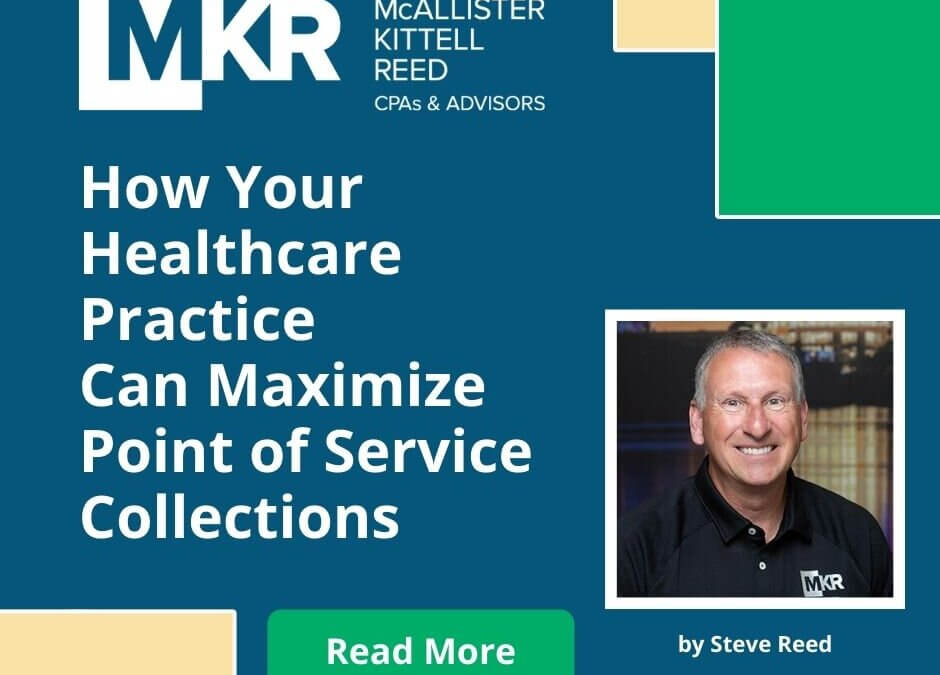
by Stephen Reed | Healthcare, Industry - Healthcare, News
Healthcare practices rely on prompt payment for provided services to maintain financial health of their business. Point of service collections refer to the process of collecting credit card or cash payments at the time of service, rather than going through a billing cycle, which can take months. Below we’ll go over some of the ways that healthcare practices can use point of service collections efficiently in order to cut the billing cycle, improve cash flow, and get paid more quickly while providing a positive experience for patients.
Train Staff to Discuss Payment Options in a Way That is Polite and Professional
Staff members who interact with patients should be trained to discuss payment options and expectations in a polite and professional manner. They should be prepared to explain services as they relate to a patient’s bill and answer any questions the patient may have about the billing process. This helps the patient feel comfortable paying their bills without confusion, surprise, or frustration regarding the cost of care. Transparency and approachability also help to build positive relationships with patients.
Offer Multiple Payment Options
Accepting multiple forms of payment increases your chances of receiving payment more promptly. Offering flexibility with methods of payment, including credit cards, checks, debit cards, cash, and virtual payments like Apple and Google Pay makes payment more convenient for patients. You can also consider offering payment plans or financing options for patients who cannot afford to pay in full at the time of service. Offering payment options that fit a patient’s financial situation can help ensure timely payment and build trust with patients.
Be Proactive and Transparent About Payment Expectations
By providing pricing transparency and establishing financial responsibilities, you help to create a more successful patient/provider relationship. This information can be provided over the phone, during the appointment scheduling process, or through the practice’s website. Staff should be prepared to provide a price estimate upfront, discuss the various payment options available to patients, and emphasize that point-of-service payment is preferred.
Use Technology to Streamline Payments
Medical billing software with an integrated payment processing platform that allows for point of service payments is essential in collecting up-front payments from patients. Look for one that offers point of service collections as a default. You could also implement a patient portal where patients can view and pay their bills online. This will help streamline point of service collections, reduce administrative burdens, and improve collection rates.

by Daniel Kittell | Accounting News, Healthcare, Industry - Healthcare, News, Uncategorized
Medical debt in the United States outpaces student loans, auto loans, and credit card debt. And with more financial responsibility falling on the patient than ever before, healthcare practices are being forced to come up with new ways to collect money owed — for profitability, but also for patient flexibility in order to incentivize patients to seek the care they need without fear of how it will affect their pocketbooks. Below are some successful, reliable methods for improving payment processes while providing convenience and options for patients.
Flexible Payment Options Are a Post-Pandemic Reality
The Covid-19 pandemic accelerated the move to more digital payment options for patients. Contactless payments were safe during the height of the pandemic, but they’re also convenient. Online portals, mobile apps, and mobile wallets allow patients to pay their medical bills quickly and safely without needing to stop by the office or wait on a phone call during specific business hours. Here’s how flexible payment options help greatly in retaining satisfied customers.
They Address Patient’s Financial Needs While Also Benefitting Providers
Flexible payment options include methods like splitting large balances into manageable monthly installments, and offering lump-sum discounts or automatic recurring payment plans. Not only does research back the success of these methods in collecting payment from customers, but flexible payment options also reduce bad debt and boost patient loyalty.
Digital Payment Options Translate to Quicker Payment Collection
Digital payment methods are fast and simple, and research backs that patients pay their medical bills more quickly when prompted via digital notification such as text, email, or automated phone call rather than through regular mail. When you send quick reminders through familiar digital platforms that patients already use, the result is typically quicker payment collections and fewer outstanding balances.
Reduce Paper Waste
The cost of healthcare billing can be cut drastically by moving from paper statements to digital reminders. Flexible payment options eliminate the need to over-send paper billing statements. For instance, implementing a card-on-file option can provide a way to process an outstanding balance with a patient’s stored credit card once insurance claims are determined. Additionally, many online payment solutions include email billing reminders, giving providers the opportunity to prompt collection of payments from one platform.
By leveraging technology to implement digital and automated payment methods, healthcare organizations can boost efficiency, cut billing expenses, and allow staff more breathing room to concentrate on improving patient experiences.


